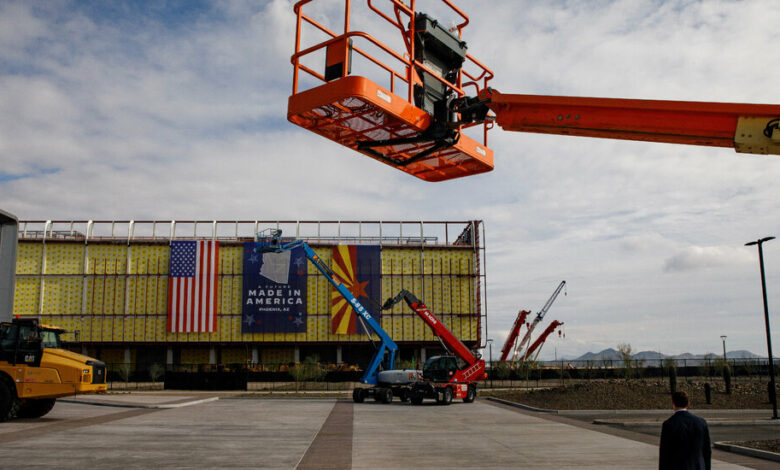US creates global high-tech supply chains to reduce risks with China

If it were up to the Biden administration, many more electronic chips would be made in factories in places like Texas or Arizona.
They are then shipped to partner countries such as Costa Rica, Vietnam or Kenya, where they are assembled and sent out into the world to power everything from refrigerators to supercomputers.
Those places may not be the first to come to mind when people think of semiconductors. But government officials are trying to transform the global chip supply chain and are in intense negotiations to do so.
Key elements of the plan include attracting foreign companies to invest in chip production in the United States and finding other countries to set up factories to finish the job. Washington officials and researchers call it part of the new “chip diplomacy.”
The Biden administration claims that producing more of the tiny brains of electronic devices in the United States will make the country more prosperous and safer. President Biden boasted about his efforts in his Friday interview with ABC News, in which he said he had pushed South Korea to invest billions of dollars in making chips in the United States.
But a key part of the strategy is playing out beyond America’s borders, where the administration is working with partners to ensure that investments in the United States are more sustainable.
If the fledgling effort goes ahead, it could help the administration achieve some of its broad strategic goals. It aims to ease security concerns about China, which is expanding its chip production while threatening Taiwan, a global center of chip technology. And it aims to reduce the risks of disruptions to the chip supply chain — risks that have been highlighted during the coronavirus pandemic and the war in Ukraine, both of which have roiled global shipping and manufacturing.
“The focus is on how best to expand capacity across a diverse group of countries to make those global supply chains more resilient,” said Ramin Toloui, a Stanford professor who recently served as assistant secretary of the State Department’s Bureau of Economic and Business Affairs, which focuses on the vanguard of diplomatic efforts to set up new supply chains.
The government wants to do this not only for chips, but also for green energy technology such as batteries for electric vehicles, solar panels and wind turbines. China is by far the largest player in those industries.
Biden and his aides say the dominance of Chinese companies is a national security and human rights problem, since some manufacturing takes place in Xinjiang, a region of China where officials force members of certain Muslim ethnic groups to work in factories.
During the three years of the Biden administration, the United States has has attracted According to Mr Toloui, $395 billion will be invested in semiconductor production and $405 billion in the development of green technology and clean energy generation.
Many of the companies investing in that kind of manufacturing in the United States are based in Asian countries known for their technology industries — Japan, South Korea and Taiwan, for example — and in Europe. One is SK Hynix, a South Korean chipmaker that is building a $3.8 billion factory in Indiana. The State Department says the project is the largest investment ever in that state and has the potential to bring more than 1,000 jobs to the region.
Secretary of State Antony J. Blinken mentioned that project in a speech last month at a conference in Maryland aimed at boosting foreign investment in the United States. And he stressed how he hoped legislation passed by Mr. Biden would attract foreign investment to American high-tech manufacturing by “modernizing our roads, our rail, our broadband, our electric grid.”
Policy efforts, he added, are aimed at “strengthening and diversifying supply chains, boosting domestic manufacturing and stimulating key industries of the future, from semiconductors to clean energy.”
The Commerce Department also plays a major role in strengthening the chip supply chain, providing $50 billion to U.S. companies and organizations for chip research, development and manufacturing.
Gina Raimondo, the Commerce Secretary, led an in-depth review of global chip supply chains to identify vulnerabilities and worked with foreign governments to discuss opportunities for additional investment abroad.
The issue was central to Ms. Raimondo’s trip to Costa Rica last spring, where she met local officials and executives from Intel, which operates a manufacturing plant there. (Mr. Toloui spoke at a Semiconductor Manufacturing Conference (Costa Rica in January.) During trips to Panama and Thailand, she also discussed diversifying the semiconductor supply chain.
But restructuring global supply chains to reduce their reliance on East Asia will be a challenge. East Asian chip factories offer more advanced technology, a larger pool of talented engineers and lower costs than U.S. factories are expected to.
Taiwan produces more than 60 percent of the world’s chips and nearly all of the most advanced chips used in computers, smartphones and other devices.
For comparison, according to various estimates, the U.S. semiconductor industry could face a shortage of 90,000 workers in the coming years.
Governments in China, Taiwan, South Korea and other countries also aggressively subsidize their own chip industries.
Still, billions of dollars in new U.S. investment is expected to shift global supply chains somewhat. The U.S. share of global chip production is expected to rise to 14 percent by 2032, from 10 percent now, according to a May report from the Semiconductor Industry Association and the Boston Consulting Group.
Some government officials have employed a more coercive form of chip diplomacy to prevent China from developing versions of U.S. technology. That approach focuses on convincing a handful of countries — Japan and the Netherlands in particular — to block companies from selling certain chipmaking tools to China.
Alan Estevez, head of the Commerce Department’s bureau responsible for export controls, visited Japan and the Netherlands last month to try to convince the countries to ban companies there from selling certain advanced technology to China.
In contrast, Mr. Toloui and his aides have flown around the world to scout countries and companies that might want to invest in U.S. manufacturing and set up factories that would be the end point of the supply chain. Mr. Toloui said his office’s work was part of Mr. Biden’s recent introduction of legislation to create more manufacturing jobs in the United States, including the Infrastructure Act and the CHIPS and Science Act.
The CHIPS Act includes $500 million in annual funding for the government to create secure supply chains and protect semiconductor technology. The State Department is using that money to identify countries to develop supply chains. Officials are conducting studies in a range of countries to see how infrastructure and labor can be brought up to certain standards to ensure smooth chip assembly, packaging and shipping.
The countries currently in the program are Costa Rica, Indonesia, Mexico, Panama, the Philippines and Vietnam. The US government is including Kenya.
Job training is a priority in this supply chain creation, Mr. Toloui said. He has been talking to Arizona State University about working with foreign institutions to develop training programs. One such institution is Vietnam National University in Ho Chi Minh City, which he visited in May.
Martijn Rasser, director of Datenna Inc., a research firm focused on China, said this network of alliances is a strategic advantage the United States has over China.
For the United States to try to do everything itself would be too expensive, he said. And going it alone would fail to recognize the reality that technology is much more dispersed around the world today than it was a few decades ago, with different countries playing important roles in the chip supply chain.




